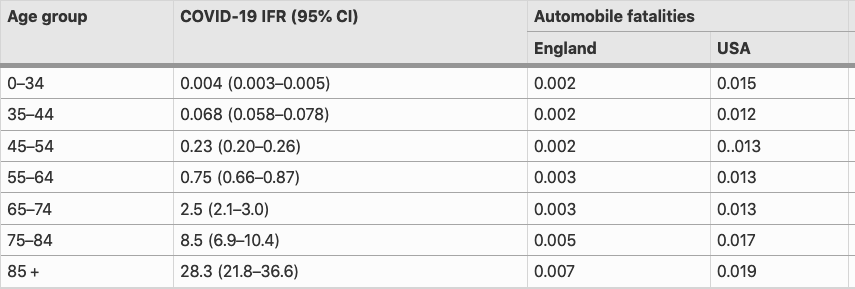A: Yes- BUT those odds are not as good as they sound.
Ask yourself- would you let your family board a plane if 1 out of 100 passengers were going to be thrown out of the plane mid-flight?
We continue to hear the “99% survivable” argument as a reason not to get the COVID-19 vaccine. This is often accompanied by “I trust my immune system.”
The Nerdy Girls are in the business of statistics and public health, so we *totally get* and *applaud* the desire to put risks in context. In 2019 there were roughly 36,000 automobile deaths in the United States, each one a tragedy for a family. And yet, we do not generally recommend not driving to reduce this risk.
We DO however create rules of the road and invest in new technologies like seatbelts, air bags, and safer roads to make driving as safe as possible, which has more than halved the automobile fatality rate from the 1970s to today. (Also, if there was a vaccine that could prevent me from dying in a car accident, I would be ALL IN!!)
➡️ So, what is the actual fatality rate for COVID-19 *if you are unvaccinated*? How does that equate to other risks in daily life?
First, a refresher on mortality rates. The Infection Fatality Rate (IFR) is the fraction of people who die of COVID-19 out of *everyone* who has been infected.
In other words, if infected with COVID-19 (unvaccinated), what are the chances I will die (on average)?
While the IFR was difficult to estimate early in the pandemic due to lack of testing, we’ve gotten a better grasp on this over time thanks to a variety of seroprevalence (antibody) studies that help us better estimate the true number of infections (the all important denominator).
So, what is the best estimate for the IFR? As we’ve previously discussed, a single IFR is not hugely useful, because it varies *tremendously* with age. This means the IFR for a country depends on the age composition of the population as well as the ages who gets infected. #demography
➡️ Our current best estimate of the *overall* IFR (pre-vaccine), averaged across many countries, is 0.68%, but this ranges from 0.004% for ages 0-34, 0.75% for ages 55-64, 2.5% for ages 65-74, and 28.3% for those 85+ (see attached table).
How do these rates compare to the chances of dying in an automobile accident each year?
Looking at the table below, we can see that if you are under 35 you have *less* risk of dying from COVID-19 if infected than your chance of dying in a car accident over a year in the U.S. (but not England, which has noticeably lower automobile fatality rates–partly due to fewer miles driven).

For anyone ABOVE age 35, the risk of dying of COVID-19 if infected becomes MANY times higher than the risk of death from a whole year of driving.
The risk of dying from COVID-19 is 18X the risk of death from a year of driving for Americans aged 45-54, rising to 58X the risk for 55-64 year-olds, 192X for 65-74 year-olds, and a stunning 500X the risk for 75-84 year-olds.
For anyone over age 20, COVID-19 infection is also many times more deadly than the seasonal flu (~15 X as deadly for 50 year-olds).
⚠️ Finally, remember that death is only the tip of the iceberg as far as the physical effects of this virus, with many times more hospitalizations than deaths and evidence of potential long-term organ damage and “Long Covid” for those infected.
As Dr. Lynora Saxinger poignantly wrote in this twitter thread after a recent shift at her hospital:
“>99% survive” has a lot of hidden realities:
“Survival” includes sedated on a ventilator for >1 month, scarred infected lungs teeming with bacteria that are hard to clear from dead tissue…brain bleeds from ECMO, critical illness myopathy and neuropathy (muscle and nerve damage), delirium- confusion, real doubt the lungs can ever heal even though they survived oxygen saturation’s of 50-70…in people 20-50 years old.”
“>99% survive” also includes people who spend days-weeks gasping for breath on oxygen, fevers, aches-who leave hospital with severe weakness and muscle loss, complications like blood clots and a long road ahead.”
“The other 99% includes: People who get miserably sick at home, some short of breath, fatigued who weeks later still can’t do what they used to, worried they’ll go have to back to work and not manage. And lucky ones who got a cold and got better.”
So, while “99% survivable” sounds like no big deal, the next time you hear this:
➡️ Propose the airplane roulette game…would you get on that plane? If you had to get on that plane, would take a very safe vaccine to avoid a 1/100 chance of getting thrown of the plane?
➡️ Remind them that death is not the only serious outcome with COVID. Ventilators and scarred lungs are no joke.
💥 Vaccines DRAMATICALLY reduce the risk of death compared to being unvaccinated (like 99% LOWER risk of death).
While risk is indeed part of daily life, risks that are *preventable* do not need to just be accepted or minimized.
If there was a jab to prevent 99% of deaths due to accidents or cancer for instance, the Nerdy Girls hope everyone would JUMP on that (ooh- there is for some cancers. . .get your HPV vaccine!).
💪 We trust our immune systems too, which is why we’ve given it extensive training and a preview of our opponent’s plans before it enters the ring with SARS-CoV-2.
Don’t throw away your shot!
Stay Safe and Stay Sane.
Love,
Those Nerdy Girls
Links:
Source for age-specific IFRs: “Assessing the age specificity of infection fatality rates for COVID-19: systematic review, meta-analysis, and public policy implications”
Is COVID really worse than the flu?
Are we over-counting COVID-19 deaths?


